Living in Central Texas and saw some birds but are not sure which ones they were?
Texas is known for its wildlife, and according to the Texas Bird Records Committee (TBRC), there are over 650 species of birds there.
Examples of birds in Central Texas include the black vulture, sandhill crane, American white pelican, purple martin, bald eagle, blue jay, and many others.
Some of these Central Texas birds, like the black vulture and turkey vulture, can be seen year-round in the state, while others, like the sandhill crane and the white pelican, will only spend winters there.
Table of Contents
Birds In Central Texas
Carolina Chickadee
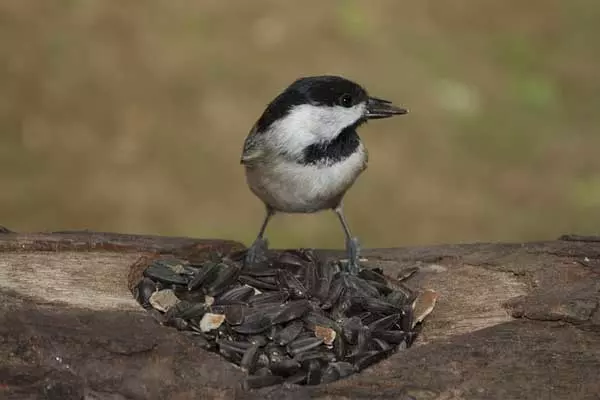
Scientific name: Poecile carolinensis
Lifespan: up to 10 years
Wingspan: 6-8 in
These small birds found in Central Texas have distinctive black caps and bibs, dull white cheeks, gray backs, and white underparts. Their beaks are dark and short, the wings are short, and the tails are moderately long.
Carolina chickadees look similar to black-capped chickadees – the main difference between the two species is the smaller size of Carolina chickadees and the lower and fuller voice of black-capped chickadees.
Carolina chickadees can be found throughout the year in Central Texas. Look for them in tree branches of mixed or deciduous woods where they hop along searching for insects.
When the weather gets very cold, Carolina chickadees might enter torpor – a state of sleep where they lower their body temperature, breathing rate, heart rate, and metabolic rate to survive the winter months.
Black Vulture

Scientific name: Coragyps atratus
Lifespan: 10 years in the wild
Wingspan: 52-66 in
This large raptor is also known as the American black vulture. You will recognize a black vulture by a sooty black plumage, a bare black head, and white tips of the wings.
It usually lives in forests and open areas of southeastern United States, Mexico, Central, and South America.
In Texas, this large bird is a year-round resident in the Central and eastern two-thirds of the state. The black vulture is protected under the Migratory Bird Treaty Act and you can’t kill it without a permit.
People often mistake it for the turkey vulture – the black vulture is a bit smaller, has shorter wings and tail, and white color patches on its wings.
Black vultures are monogamous and pairs are believed to mate for life – both the male and female will take turns incubating their eggs.
They can be very aggressive which makes other vulture species avoid them.
Black vultures are carnivores that feed on carrion but may also hunt and eat small reptiles, birds, and mammals.
To escape from danger, these large birds of Central Texas might regurgitate partially digested food to distract the attacker and become lighter before flying away.
Turkey Vulture
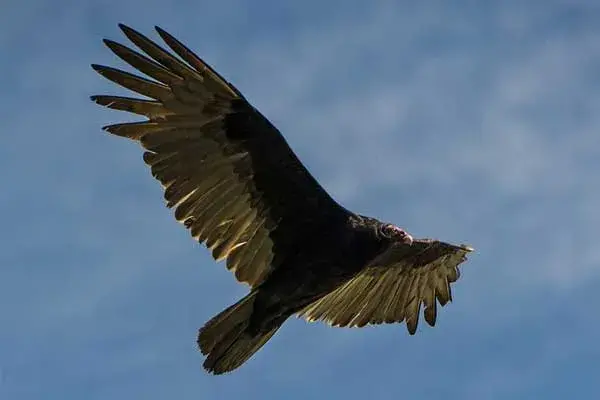
Scientific name: Cathartes aura
Lifespan: 16 years in the wild
Wingspan: 63–72 in
The Turkey vulture is the largest vulture found in Texas and can be seen throughout the year in central parts of the state.
It is also known as the turkey buzzard (or just buzzard) and got its original name due to its resemblance to a wild turkey.
A familiar sight in the Texas sky, you will recognize turkey vultures by their bald heads, dark plumage, and long, broad wings.
These birds have an impressive wingspan of around 67.5 in and are bigger than other raptors, except eagles and condors.
Some wildlife experts estimate a population of over 18 million birds.
If you decide to go after turkey vultures, look for them in the open areas including mixed farmland, forest, and rangeland.
They are gregarious birds that roost in large community groups with several hundred individuals. You might be able to spot them sitting in trees on the sides of roads waiting for their next meal.
Turkey vultures might be big and look scary, but these central Texas birds do a great service across the US by removing dead animals and preventing the transmission of any diseases those dead animals could have carried.
They can eat and digest carcasses tainted with anthrax, tuberculosis, and rabies, without getting sick because of their extremely strong stomach acids.
Sandhill Crane
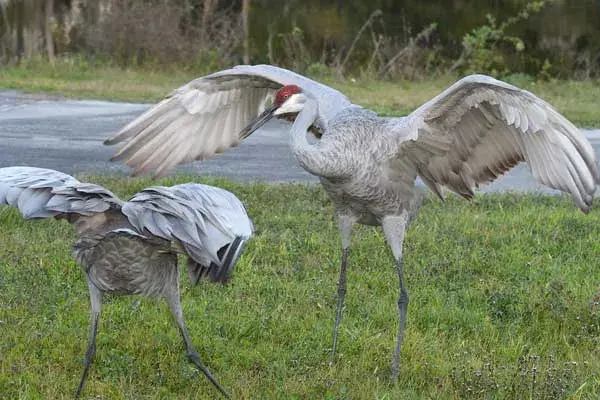
Scientific name: Grus canadensis
Lifespan: 20 years
Wingspan: 78.7 in
Sandhill cranes are one of the most striking birds found in Central Texas. They are extremely tall, have long necks and legs, and very broad wings. Sandhill cranes have a wingspan of almost 7 feet, a height of 4 feet, and an average weight of 10 pounds.
You will recognize them by their mostly slate gray plumage, rusty washes on the upperparts, pale cheeks in adults, red patches on their heads, and black legs.
Sandhill cranes will leave their northern breeding grounds and begin arriving in Texas to winter there around October. The best time to see them in central parts of the state is from December until February when their largest numbers are in the state. Most of them will leave around the end of March.
Sandhill cranes are fairly social birds and can be usually found in pairs or family groups throughout the year.
They are also monogamous and mate for life, staying together for years, until one of the cranes dies.
Sandhill cranes mostly feed on plants, some insects, and snails.
American White Pelican
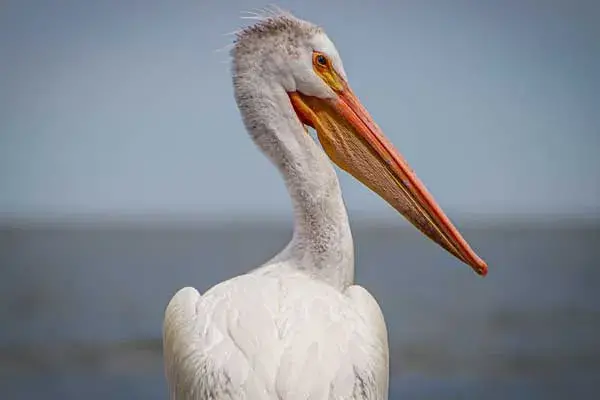
Scientific name: Pelecanus erythrorhynchos
Lifespan: 16-30 years
Wingspan: 95-120 in
With a wingspan of up to 120 in and a weight of up to 30 pounds, American white pelicans are the largest birds in Texas. They also have the largest beak of any other North American waterbird, measuring 11.3-15.2 inches in males and 10.3-14.2 inches in females.
These huge aquatic birds live in inland shallow freshwater lakes, wet prairies, and marshes in the summer, and on coastal lagoons in the winter.
You will recognize them by their size, white plumage color with black flight feathers that are visible only when the wings are spread. American white pelicans also have vivid yellow-orange beaks and legs.
Unlike brown pelicans, which are year-round Texas residents, American white pelicans migrate to the state to spend the winter there. Look for them arriving in Central Texas from September to late November.
Although a small population might remain on the Texas coast year-round, most of the American white pelicans will leave the state around March and move north to breed in the northern part of the Western USA and Canada.
Their diet mostly consists of fish, but also some crayfish and salamanders.
A group of pelicans is called a “brief” and a “squadron”.
Downy Woodpecker
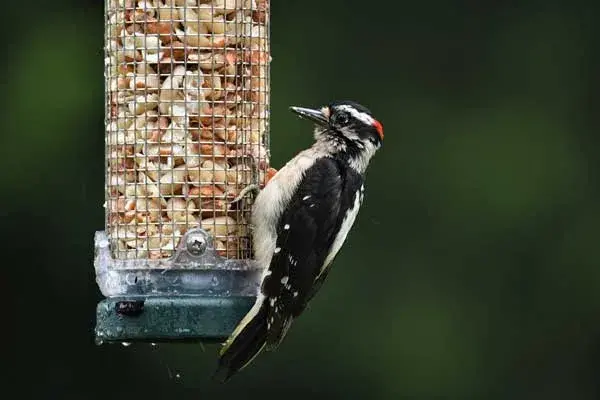
Scientific name: Picoides pubescens
Lifespan: up to 11 years
Wingspan: 10-12 in
Downy woodpeckers are a familiar sight at backyard feeders, in parks, and in woodlots of Central Texas throughout the year. They are also the smallest species of woodpecker in Texas (and North America).
To identify downy woodpeckers in nature, notice the black color of the upperparts and wings, white backs, throats, and bellies, and white spottings on the wings.
You can also see one white bar above and below the eyes. Adult males have red patches on the back of their heads.
They can hit the tree bark over 10 times per second and have special feathers around their nostrils to save them from breathing in wood chips.
Downy woodpeckers are omnivores that mostly feed on insects, beetle larvae, ants, and caterpillars, but also berries, acorns, and grains.
Look for them around bird feeders, they will often eat suet and black oil sunflower seeds and occasionally drink from hummingbird feeders.
Downy woodpeckers are monogamous and the pair will together prepare a nest in the tree. The female will then lay from 3 to 8 eggs.
These woodpeckers are also common in Northern California.
Great Horned Owl

Scientific name: Bubo virginianus
Lifespan: 15-25 years
Wingspan: 35.8-60.2 in
The great horned owl can be seen throughout the year in Central Texas. It is the largest owl in the state that measures almost two feet in length and can weigh up to 3.5 pounds.
This majestic owl is also the largest in North America and can be found in mountains, grasslands, conifer forests, deserts, chaparrals, and many other habitats.
The great horned owl has the most diverse diet of all North American raptors. It is a very aggressive hunter that preys on rabbits, hares, rats, mice, voles, other small mammals, larger mid-sized mammals, reptiles, amphibians, and invertebrates.
It might occasionally even attack larger prey, including raptors such as ospreys, Peregrine falcons, prairie falcons, and other owls.
The great horned owl relies on its acute hearing and excellent eyesight to locate the prey. It will then fly in near silence to catch the unsuspecting animal by surprise.
In case you see a great horned owl in person, you will notice long, earlike tufts, intimidating yellow eyes, and a deep hooting call. It has a gray-brown plumage with a mottled pattern and a white patch at the throat.
Great horned owls are monogamous birds and may stay together for over five years, sometimes even for a lifetime.
Canada Goose

Scientific name: Branta canadensis
Lifespan: 10-24 years
Wingspan: 50-73 in
With a weight of over 14 pounds and a length of up to 43 inches, the Canada goose can be easily spotted during winter in central and eastern parts of Texas.
You will identify this large bird by a black head and neck, white cheeks, white under its chin, and a brown body.
Although Canada geese spend winters in Texas, their numbers there have been on the decline.
During some recent mid-winter surveys of Texas coastal zones, scientists spotted only around 100 of these birds. Their numbers have been low due to the reduction of rice and corn production in the state – something these birds love eating.
Canada geese can be found in urban and cultivated habitats with lots of food and few natural predators.
There are 7 subspecies of Canada goose – one of them, the giant Canada goose (B. c. maxima), is considered the largest goose in the world.
Canada geese are known for flying in a distinctive V-formation and series of loud “honks” calls.
Great Blue Heron
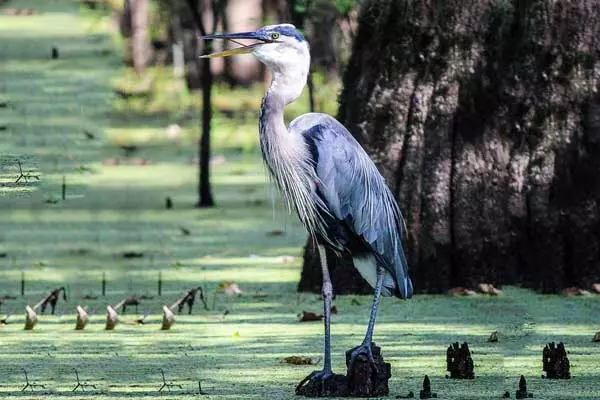
Scientific name: Ardea herodias
Lifespan: 15 years
Wingspan: 66–79 in
With a wingspan of over 6.5 ft and a length of up to 4.25 ft, these birds are the largest of North American herons and one of the biggest birds found in Central Texas. Great blue herons can be seen year-round in the state.
You will identify them by their large yellow-orange beaks, short black plumes on their heads, and black and chestnut pattern on their shoulders. Look for them around shores of open water and wetlands. Great blue herons tend to hold their necks in an S-shape with their legs trailing behind while flying.
They are monogamous only for a single season and will go through some interesting courtship rituals, locking and rubbing their bills on the feathers of the other bird before mating.
After successful mating, both parents will take turns and incubate the eggs, and after hatching, the chicks can fly at only 2 months of age.
They nest in colonies called heronries that can occasionally have more than 500 nests.
Great blue herons are carnivores that feed on fish, amphibians, reptiles, invertebrates, small mammals, and even other birds.
You can often spot them slowly stalking their prey in shallow waters and catching it with their long and sharp bills.
Read More: 14 blue birds that live in Pennsylvania
Northern Mockingbird
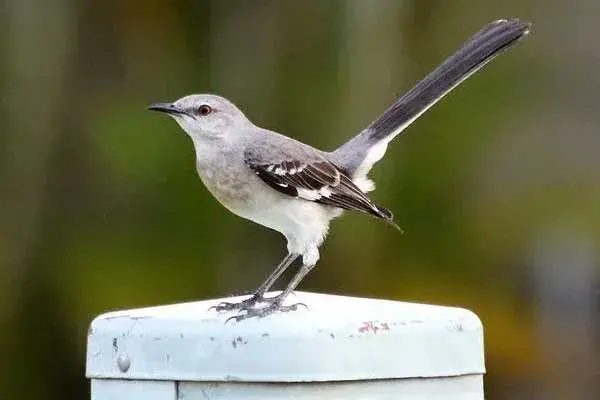
Scientific name: Mimus polyglottos
Lifespan: up to 8 years
Wingspan: 12-15 in
This medium-sized
throughout the year. You will easily identify the Northern mockingbird by its gray plumage with whitish underparts and a long tail.
In case you see one while it’s flying, notice the large white patches on the black wings and tail.
Those wing bars have a dual purpose: to show off during the mating season and to flash them when defending territory against some snakes and hawks.
The northern mockingbird is a state bird of Texas and can be commonly found on tall shrubs or tree branches of forest edges, backyards, and parks.
Read More: 25+ common birds that live in Central Florida
The Latin name of this bird translates to “many-tongued mimic.” A northern mockingbird can imitate chirps of up to 35 species and learn over 200 different songs in its lifetime.
They can imitate sounds of rusty hinges, whistling, cackling hens, and dogs barking so well that you couldn’t tell a difference even with an electronic analysis.
It is the only species out of 16 with the name “mockingbird” that is native to the United States.
The Northern mockingbird is a very territorial bird and very good at breeding – scientists once recorded a female that managed to lay 27 eggs in a single season!
Northern mockingbirds are omnivores that feed on fruit, seeds, berries, and small insects.
Blue Jay
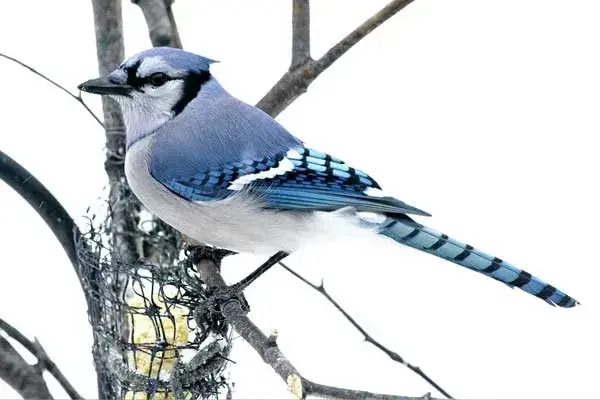
Scientific name: Cyanocitta cristata
Lifespan: 7 years
Wingspan: 13-17 in
This large nonmigratory bird can be found throughout the Central and eastern half of Texas.
The blue jay is easy to identify by a mix of black, blue, and white plumage above that is white or light gray underneath. It also has bright blue wings with white spots.
Males and females look the same.
The blue jay is not a state bird in any US state; it is, however, the mascot of a Major League Baseball team called the Toronto Blue Jays.
This songbird is highly intelligent and can use tools and imitate the sounds of predators. They might mimic the sounds of hawks when approaching a feeding site to drive away other birds.
Blue jays are very noisy birds that mate for life and work together to build a nest for their young.
When the female is sitting on the eggs, the male will feed and take care of her.
Blue jays are omnivores that mostly feed on seeds, berries, nuts, and occasionally insects. They will also store food and use it at another time.
Northern Cardinal

Scientific name: Cardinalis cardinalis
Lifespan: 3 years
Wingspan: 10-12 in
The Northern cardinal is a medium-sized songbird that is common throughout the year in Central Texas.
It is also known as the redbird and it can be easily identified by its prominent crest and a short, very thick, and vibrant orange beak.
Male and female cardinals have the same feathered head crests but still look different – males are completely red and have reddish beaks, while females are pale brown with clear orange beaks.
Northern cardinals are omnivores and feed on seeds, fruit, and insects. They got their red color from carotenoids in their food; if not enough of this pigment-triggering food is available, they become brownish.
If you live in Central Texas, you can easily attract northern cardinals to your bird feeder, especially if you add some sunflower seeds.
Males sometimes have baldness problems – it’s a sign they’re in the middle of a late summer molt. These birds are extremely territorial and aggressive – northern cardinals will often try to ferociously attack their reflections in the mirrors and windows.
They are also monogamous and mate for life.
American Robin

Scientific name: Turdus migratorius
Lifespan: 2 years
Wingspan: 12-16 in
The American robin is a migratory songbird and a common sight on lawns across Central Texas throughout the year.
You will identify this bird by its red breast, gray wings, head, and back. It has a short beak that has a bright color, mostly orange-yellowish, and a gray tip. Look for large flocks of birds, sometimes up to 10,000 individuals.
The American robin is the state bird for Connecticut, Michigan, and Wisconsin.
It has a sweet tooth and will feast on fruits, berries, and even cakes and pastry.
American robins are omnivores and will also eat earthworms, caterpillars, and insects.
Eastern Bluebird

Scientific name: Sialia sialis
Lifespan: 6-10 years
Wingspan: 9-12 in
Commonly found in Central Texas year-round, the Eastern bluebird is a marvelous bird to capture in your binoculars. It breeds from mid-February to late July in the state.
This small North American migratory thrush can be recognized by its big, rounded head, large eyes, and alert posture. Males have vivid royal blue wings heads and back plumage, and warm red-brown and white breasts.
The Eastern bluebird is the most widespread of the three bluebird species and can be found in open country with scattered trees, farms, and roadsides in eastern parts of North America.
Similar to their relatives, mountain bluebirds, the eastern bluebirds are cavity nesters that love nest boxes.
They are also very social birds that can live in flocks with over 100 individuals. Eastern bluebirds can be very territorial.
To attract a female, a male bluebird will sing over 1,000 songs per hour; it sings without opening its beak wide.
These birds are omnivores that mostly feed on insects, including grasshoppers, crickets, beetles, caterpillars, and some fruit.
The eastern bluebird is the official bird of Missouri and New York.
Read More: What are some of the most colorful birds of Texas?
White-winged Dove
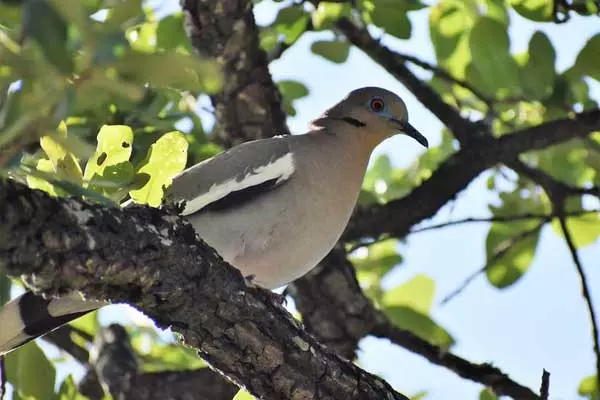
Scientific name: Zenaida asiatica
Lifespan: 10-15 years
Wingspan: 21 in
This semi-tropical bird can be found in thorny forests, streamside woodlands, and even in deserts. In Central Texas, the white-winged dove can be seen during summer; some populations might remain year-round in the state.
It has grayish-brown plumage and a conspicuous white patch on its wings. When perched, the white patch looks like a line along the bottom edge of the wing which is how the species got the name.
These birds can fly 25 or more miles to find water and while migrating, their flocks can have over 4,000 birds.
White-winged doves are herbivores that feed on seeds, including sunflower, milo, corn, safflower, and some berries from shrubs.
Cedar Waxwing

Scientific name: Bombycilla cedrorum
Lifespan: up to 8 years
Wingspan: 9-12 in
This medium-sized, sleek bird can be identified by its large head, short neck, and short bill. Cedar waxwing has pale brown on the head, soft gray on the wings, pale yellow on the belly, and gray with bright yellow tips on the tails.
Cedar waxwing is one of the prettiest and most popular birds with yellow tails seen in Central Texas. It can be seen in the state from mid-October to late May.
Cedar waxwing got its name from the waxy red tips on its secondary wing feathers.
Its habitats range from deciduous and evergreen woodlands to orchards, suburban parks, and backyards.
The cedar waxwing is one of the few North American birds that can survive eating only fruit for several months.
If the bird eats enough of the honeysuckle fruit while it is growing, the tip of the tail will turn from yellow to orange.
Spotted Towhee
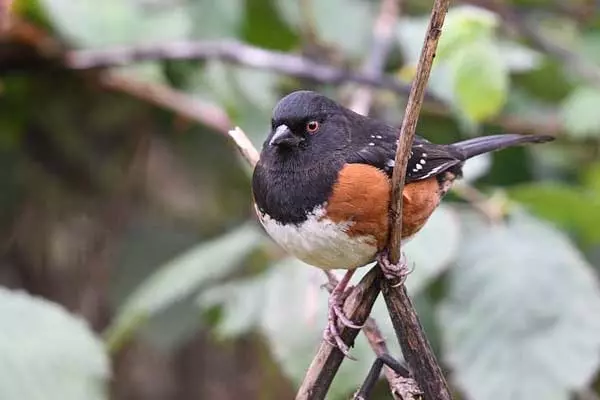
Scientific name: Pipilo maculatus
Lifespan: up to 12 years
Wingspan: 11 in
These large, striking, and long-tailed sparrows can be seen in central parts of Texas from early October until late May.
Spotted towhees are black above, have white spots on their wings and backs, bright rufous on the sides, and white on their bellies. They also have bright red eyes and dull pink legs.
Spotted towhees can be found in dry upland forests, open forests, brushy fields, and chaparrals. They will often nest on the ground or low in bushes.
Spotted towhees can be often seen hopping along the ground, scraping away leaf litter, and looking for insects, beetles, spiders, acorns, seeds oats, and berries.
They often visit bird feeders so you might be able to attract them.
American Goldfinch
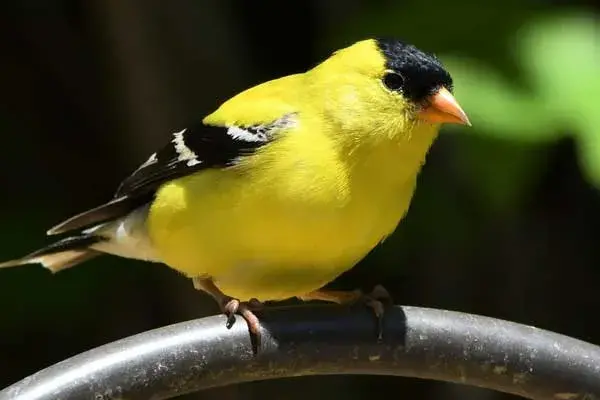
Scientific name: Spinus tristis
Lifespan: 3-6 years
Wingspan: 7.5-8.7 in
This small migratory bird has a small head, long wings, and a short, notched tail. American goldfinch can be seen during winter in Central Texas, arriving in the state around fall.
Listen for its winter calls that sound like “per chi cor ree.”
It is named “wild canary” for its bright yellow plumage in the spring and summer. During the winter months, males get an olive color while the females become dull yellow-brown.
Male and female American goldfinches have a colorful carotenoid-based orange bill during the breeding season; the bill serves as an indicator of the overall health of the bird.
The more saturated with orange a bill is, the higher the testosterone levels are in that specific bird.
American goldfinches molt twice a year, once in late winter and again in late summer.
They are the state bird of New Jersey, Iowa, and Washington.
American goldfinches are one of many examples of small birds in Texas. See the full list here.
Ruby-throated Hummingbird
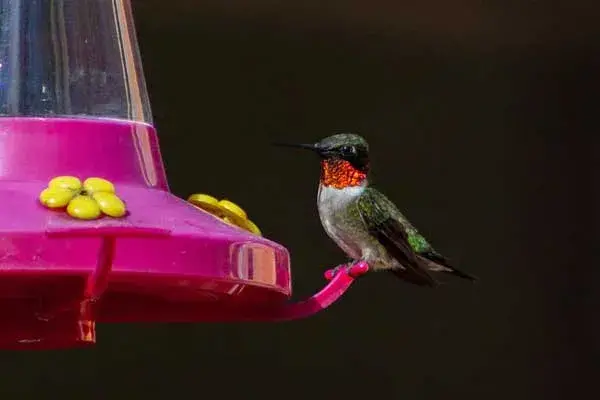
Scientific name: Archilochus colubris
Lifespan: 3-5 years
Wingspan: 3.1-4.3 in
The ruby-throated hummingbird is a beautiful bird that has a brilliant iridescent red throat.
You can see it in the central parts of Texas during summer. Look for males that arrive in spring one or two weeks before the females, from late February to mid-March. Ruby-throated hummingbirds will remain in the state until September before moving south for winter.
Both sexes look different.
Males have metallic emerald green upperparts, grayish-white underparts, black wings, and a gorget (throat patch) of iridescent ruby red. Their tails are forked.
Females are larger than males, have slightly shorter beaks, and have white throats.
Ruby-throated hummingbirds move very quickly, around 25 mph, and will beat their wing over 50 times per second.
They only have about 940 feathers on average which is the smallest number in any bird.
These birds are mostly solitary, except during the breeding season which lasts a few days.
To attract these hummingbirds with red necks to your backyard, you can set up hummingbird feeders or plant tubular flowers. They are quite bold and might even feed at hanging plants and feeders on your porch or next to your windows!
Painted Bunting

Scientific name: Passerina ciris
Lifespan: 5-10 years
Wingspan: 8-9 in
Painted buntings are one of the most colorful North American birds. They look so pretty that people sometimes call them “nonpareil”, meaning “unrivaled.”
Males have a stunning blue color of their heads, red underparts, and green backs. Females usually have bright yellow-green colors.
Painted buntings are birds with blue heads that can be found in different parts of Texas, Arkansas, Alabama, Oklahoma, Florida, and Louisiana.
In Central Texas, they can be seen during summer. Look for them from April until October.
Although painted buntings are common in the state, you might have trouble finding them there since they like to stay in deep brush except early in the morning when the male sings.
Visit streams, forest edges, and other areas with dense understory.
They might look cute and colorful, but painted buntings are aggressive birds. They are very territorial and will attack other males of their species.
Painted buntings are omnivores that mostly feed on seeds and insects.
A group of painted buntings is known as a “mural” and a “palette”. Certainly suits their name!
Read More: Examples of common backyard birds of San Antonio
Purple Martin
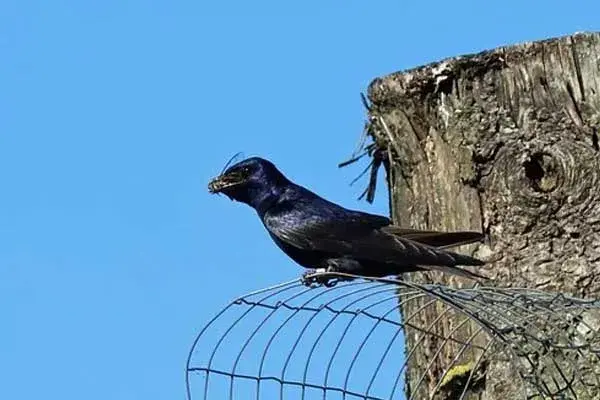
Scientific name: Progne subis
Lifespan: 5-7 years
Wingspan: 15 in
Purple martins are the largest swallows in North America. They are famous for their chattering song and aerial acrobatics.
These central Texas birds will winter in the rainforests of Brazil and then undertake a 7,000-mile-long migration trip back into the eastern United States and Canada.
Read More: 5 types of loons that live in Canada
After spending 5 months in South America, the first purple martins of the year can be spotted in Central Texas around the 15th of March. You will see males that usually arrive before the females.
Talking about their appearance, purple martins are easy to identify by their slightly hooked beaks, short and forked tails, and long, tapered wings.
Adult males are dark overall with a purplish-blue shimmer visible at close range.
Depending on the light and angle, their head color may appear to be royal blue, navy blue, or deep purple. Females are grayer with shine on the crown and back.
Males that arrive in Texas first will scout for new or unoccupied martin houses but the females are the ones that make the final decision.
Pairs typically build their nests out of straw, twigs, and pine needles.
They are very social and colonial birds – the largest roosting colony ever discovered had over 700,000 birds!
Interested in learning more about birds that live in Western Pennsylvania? Check this article.
Common Grackle
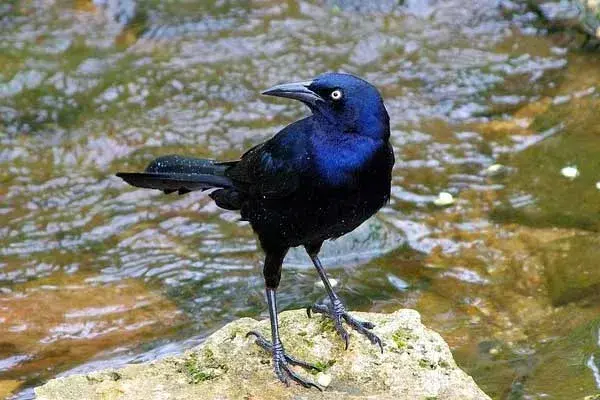
Scientific name: Quiscalus quiscula
Lifespan: 17-22 years
Wingspan: 14-18 in
Common grackles are one the most common blackbirds with blue head color.
These medium-sized Texas songbirds are easy to recognize by their long, keel-shaped tails, dark beaks, yellow eyes, and (in males) glossy black plumage with sheen blue-green head colors.
Common grackles have a population of over 70 million individuals and can be found in wet, open woodlands, marshes, as well as suburbs, parks, and agricultural fields.
They are short-distance migrants that breed across North America east of the Rocky Mountains. In Central Texas, many populations can be seen year-round.
Common grackles are omnivores and feed on insects, minnows, frogs, eggs, berries, seeds, and grain.
They will let ants crawl up their bodies and clean them from parasites. If no ants are available, grackles will use lemons, walnut juice, and mothballs for that purpose.
In several US countries, including Texas, it is illegal to kill grackles.
Read More: All 3 species of grackle found in Texas
Ruby-crowned Kinglet

Scientific name: Regulus calendula
Lifespan: up to 5 years
Wingspan: 6.3-7.1 in
Often hard to see in summer, when it lives high in tall conifers, ruby-crowned kinglet will often flit low in woods and thickets during winter.
This stunning green bird will arrive in central Texas around fall, winter in the state, and depart for the north by early May.
In case you live in this part of the state, mid-September to early May is the best time to go looking for these birds.
Ruby-crowned kinglets are one of North America’s smallest songbirds and can be identified by their olive-green plumage with two white wing bars and white eye-rings.
Male ruby-crowned kinglets also have red crown patches, which are usually concealed.
Ruby-crowned kinglets build cup-shaped nests and have the largest clutch of any North American passerine for its size. A female may lay up to 12 eggs and that entire clutch can weigh as much as the female herself.
These birds are omnivores that mainly feed on insects, some fruits, and seeds.
Read More: List of birds found in Southern California
Barn Swallow

Scientific name: Hirundo rustica
Lifespan: 4 years
Wingspan: 12.5-13.5 in
This is the most widespread species of swallow in the world. In central Texas, barn swallow can be seen during the summer months.
In early fall, this long-distance migratory bird flies from North American breeding grounds to winter in Central and South America.
Barn swallows can be identified by blue heads and wings, rusty-orange throats and foreheads, and pale orange chests and undersides. They also have long, slender, and deeply forked tails that are a little less prominent in females.
The legend says that barn swallows stole fire from the gods and gave it to people. Gods became so angry that they threw a firebrand at the bird, burning its middle tail feathers.
Barn swallows are one of the largest swallow species found in Maryland and Pennsylvania.
Bald Eagle

Scientific name: Haliaeetus leucocephalus
Lifespan: 20-30 years in the wild
Wingspan: 70.8-90.5 in
Bald eagles are the largest raptors found in Central Texas.
You will recognize these enormous birds of prey by their commanding presence, white heads and tails, brown color, and bright yellow bills.
Bald eagles can be found throughout the year in southeastern parts of Texas; during winter you will find them in central parts of the state.
Look for them arriving in the fall and begin to migrate out in March – bald eagles breed in the state from October through February.
After recovering from 75 pairs in 1970, bald eagles are now doing very well in the state and are a common sight around lakes, rivers, and wetlands of Texas.
Some estimates claim that there are around 300 pairs of bald eagles in the state in total.
They are carnivores and opportunistic feeders that mostly consume fish, which they snatch from the water.
Bald eagles are hard to miss as they soar through the air with their 7.5-foot-wide wingspan.
These birds build the largest nests of any North American bird and the largest tree nests ever recorded for any animal species. Their nests can be up to 13 ft deep and 8.2 ft wide.
Read More: 25+ examples of birds that live in North Texas
In Summary
This concludes our list of birds in Central Texas.
Examples of central Texas birds include the beautiful painted bunting, the migratory barn swallow, the enormous white pelican, the small ruby-throated hummingbird, and many others.
Next time you see any of these birds in person, you should be able to recognize them with ease!
And if you enjoyed our article, here are our other popular reads on birds: 22+ examples of birds that have blue wings and examples of night birds found in Texas